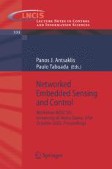Search
Search Results
-
9. Switched Scalable Video Coding Systems
Scalable video coding means that a video sequence is only encoded once and the coded bitstream has the capability of sending any sub-bitstream...
-
4. Stability of Nonlinear Switched and Impulsive Systems
In this chapter, we shall study the stability of nonlinear switched and impulsive systems of the form...
-
1. Examples and Modelling of Switched and Impulsive Systems
When you begin to read this book, you may ask: “what is a switched and impulsive system?” This is a question that may be best answered through...
-
Virtual Reality in Healthcare
In our modern 21st century, daily life would be unthinkable without computers. Multimedia and virtual reality are useful for people with special...
-
Access to Information on Demand by the aid of Digital Talking Books
This chapter addresses the concept and the fundamental ideas of the digital talking book (DTB), with a particular focus on DTBs in the DAISY format....
-
11 Random Vibrations of Large Finite Element Systems
The basic idea for the computation of the stochastic response is based on the Karhunen-Loève expansion of the stochastic loading. For each Karhunen-...
-
4 Finite Element Method
In this chapter, the fundamentals of the displacement-based finite element method are reiterated in a concise form, details can be found in a number...
-
5 Non-Linear Static Analysis
The state of the art in the capability to predict the stability behavior of shell structures refers to areas such as asymptotic analysis [69] and...
-
7 Rational Treatment of Uncertainties
Structural analysis up to this date, generally is still based on a deterministic conception. Observed variations in loading conditions, material...
-
9 Direct Monte Carlo Simulation
The evaluation of the stochastic response by the Monte Carlo simulation technique is a powerful method for highly nonlinear systems as well as for...
-
A Imperfection Data Bank
For the stochastic modeling of geometric imperfections as described in Sec. 12.1, a database [5] has been available. This database provides...
-
3 Spectral Analysis of Finite Dimensional Operators
A great number of engineering problems can be viewed as an input to output map**, as shown in Fig. 3.1, where the system represents the law for the...
-
Applications of Connectivity Graph Processes in Networked Sensing and Control
This paper concerns the problem of controlling mobile nodes in a network in such a way that the resulting graph-encoding of the inter-node...
-
Plenary Talk: Delays in Control over Communication Networks: Characterization, Impact, and Reduction Strategies
The most notable trend in manufacturing over the past five years is probably the move towards networks at all levels of industrial systems. At lower...
-
Homogeneous Semantics Preserving Deployments of Heterogeneous Networks of Embedded Systems
Tagged systems provide a denotational semantics for embedded systems. A heterogeneous network of embedded systems can be modeled mathematically by a...
-
Distributed Kalman Filtering and Sensor Fusion in Sensor Networks
The problem of distributed Kalman filtering (DKF) for sensor networks is one of the most fundamental distributed estimation problems for scalable...
-
Simulation of Large-Scale Networked Control Systems Using GTSNetS
This paper presents a simulation framework for distributed control using wireless sensor networks. The proposed framework is an extension of the...
-
Disturbance Attenuation Bounds in the Presence of a Remote Preview
We study the fundamental limits of disturbance attenuation of a networked control scheme, where a remote preview of the disturbance is available. The...
-
11 Safety Evaluation Method of Rehabilitation Robots
An aged society comes soon. Human-care robots must be realized to nurse aged and disabled persons. Human-care robot will need to work around elderly...
-
2 Rehabilitation Robotics from Past to Present – A Historical Perspective
Popular culture presents the image of a robot as a mechanical, humanoid device, often evil in intent. Those with a slightly more informed technical...
